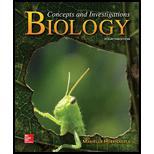
Concept explainers
Following gastrulation, the cells that have folded inward develop into
- a. endoderm.
- b. mesoderm.
- c. ectoderm.
- d. All of the above are correct.
Introduction:
Gastrulation is a period in the development of an embryo of animals, in which a single layered blastula folds itself in such a way that it forms a cup shaped structure called gastrula. Gastrula further contains two or three layers of tissue. It includes the endoderm, ectoderm and mesoderm.
Answer to Problem 1MCQ
Correct answer:
The cells that have folded inward develop into endoderm, after gone through the gastrulation phase. Therefore, option (a) is correct.
Explanation of Solution
Reason for the correct statement:
The blastula rearranges itself to develop the gastrula, following gastrulation the cells that fold inward develop into the endoderm. Endoderm is the inner most layer which contributes to the development of an embryo
Option (a) is given as “endoderm”.
As, “endoderm is the inner most layer which is formed by the folding of cells after gastrulation phase. Endoderm is the primary germ layer which contributes to the development of an embryo in early stage”, it is the right answer.
Hence, option (a) is correct.
Reasons for the incorrect statements:
Option (b), is given as “mesoderm”.
Mesoderm is the middle layer formed between ectoderm and endoderm. This is the third primary germ layer which also contributes to the development of an embryo. Mesoderm is formed by the interaction of two germ layers including ectoderm and endoderm. Hence, it is a wrong answer.
Option (c), is given as “ectoderm”.
Ectoderm is the outermost germ layer that also forms during the development of an embryo. It covers the outside of the embryo. Hence, it is a wrong answer.
Option (d), is given as “all of the above are correct”.
Endoderm, ectoderm and mesoderm all are the primary germ layers which are formed during the development of an embryo. Ectoderm is the outer layer of tissue and mesoderm is the inner layer of tissue. The cells that have folded inward result in the formation of endoderm. Hence, it is a wrong answer.
Hence, options (b), (c), and (d) are incorrect.
Endoderm is formed by the inward folding of cells followed after gastrulation. Endoderm is the primary germ layer which contributes to the development of an embryo in the early stage.
Want to see more full solutions like this?
Chapter 21 Solutions
Biology: Concepts and Investigations
Additional Science Textbook Solutions
Biological Science (6th Edition)
Applications and Investigations in Earth Science (9th Edition)
Genetics: From Genes to Genomes
Campbell Essential Biology (7th Edition)
HUMAN ANATOMY
Biology: Life on Earth with Physiology (11th Edition)
- students in a science class investiged the conditions under which corn seeds would germinate most successfully. BAsed on the results which of these factors appears most important for successful corn seed germination.arrow_forwardI want to write the given physician orders in the kardex formarrow_forwardAmino Acid Coclow TABle 3' Gly Phe Leu (G) (F) (L) 3- Val (V) Arg (R) Ser (S) Ala (A) Lys (K) CAG G Glu Asp (E) (D) Ser (S) CCCAGUCAGUCAGUCAG 0204 C U A G C Asn (N) G 4 A AGU C GU (5) AC C UGA A G5 C CUGACUGACUGACUGAC Thr (T) Met (M) lle £€ (1) U 4 G Tyr Σε (Y) U Cys (C) C A G Trp (W) 3' U C A Leu בוט His Pro (P) ££ (H) Gin (Q) Arg 흐름 (R) (L) Start Stop 8. Transcription and Translation Practice: (Video 10-1 and 10-2) A. Below is the sense strand of a DNA gene. Using the sense strand, create the antisense DNA strand and label the 5' and 3' ends. B. Use the antisense strand that you create in part A as a template to create the mRNA transcript of the gene and label the 5' and 3' ends. C. Translate the mRNA you produced in part B into the polypeptide sequence making sure to follow all the rules of translation. 5'-AGCATGACTAATAGTTGTTGAGCTGTC-3' (sense strand) 4arrow_forward
- What is the structure and function of Eukaryotic cells, including their organelles? How are Eukaryotic cells different than Prokaryotic cells, in terms of evolution which form of the cell might have came first? How do Eukaryotic cells become malignant (cancerous)?arrow_forwardWhat are the roles of DNA and proteins inside of the cell? What are the building blocks or molecular components of the DNA and proteins? How are proteins produced within the cell? What connection is there between DNA, proteins, and the cell cycle? What is the relationship between DNA, proteins, and Cancer?arrow_forwardWhy cells go through various types of cell division and how eukaryotic cells control cell growth through the cell cycle control system?arrow_forward
 Concepts of BiologyBiologyISBN:9781938168116Author:Samantha Fowler, Rebecca Roush, James WisePublisher:OpenStax College
Concepts of BiologyBiologyISBN:9781938168116Author:Samantha Fowler, Rebecca Roush, James WisePublisher:OpenStax College Biology (MindTap Course List)BiologyISBN:9781337392938Author:Eldra Solomon, Charles Martin, Diana W. Martin, Linda R. BergPublisher:Cengage Learning
Biology (MindTap Course List)BiologyISBN:9781337392938Author:Eldra Solomon, Charles Martin, Diana W. Martin, Linda R. BergPublisher:Cengage Learning
 Biology: The Dynamic Science (MindTap Course List)BiologyISBN:9781305389892Author:Peter J. Russell, Paul E. Hertz, Beverly McMillanPublisher:Cengage Learning
Biology: The Dynamic Science (MindTap Course List)BiologyISBN:9781305389892Author:Peter J. Russell, Paul E. Hertz, Beverly McMillanPublisher:Cengage Learning Biology: The Unity and Diversity of Life (MindTap...BiologyISBN:9781305073951Author:Cecie Starr, Ralph Taggart, Christine Evers, Lisa StarrPublisher:Cengage Learning
Biology: The Unity and Diversity of Life (MindTap...BiologyISBN:9781305073951Author:Cecie Starr, Ralph Taggart, Christine Evers, Lisa StarrPublisher:Cengage Learning Human Biology (MindTap Course List)BiologyISBN:9781305112100Author:Cecie Starr, Beverly McMillanPublisher:Cengage Learning
Human Biology (MindTap Course List)BiologyISBN:9781305112100Author:Cecie Starr, Beverly McMillanPublisher:Cengage Learning





